From the President: The Value of Vasco
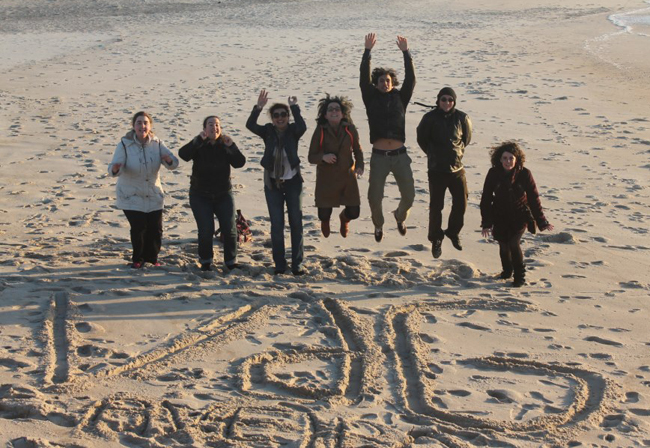
Mini Hippokrates - at the beach
español português
A recent trip to speak at a meeting in Aveiro, Portugal took me 1000 years. The actual travel time was about 24 hours. The meeting lasted three days. Yet, the journey gave me a chance to reflect back on the life of Vasco da Gama 500 years ago. It also inspired me to look ahead 500 years into the future.
The ostensible purpose of my visit was to attend the 30º Encontro Nacional de MGF (30th National Meeting of General and Family Doctors) of the Associação Portuguesa de Medicina Geral e Familiar (APMGF). Portugal has a population of about 10 million people and 40,000 doctors. APMGF has 4000 members out of the 5700 Portuguese family doctors. Women comprise an estimated 80% of family medicine physicians and trainees. Post-graduate training involves 4 years. There are about 400 new trainees each year; they represent about one quarter of medical school graduates.
A primary care team in Portugal consists typically of a physician, nurse, and administrative assistant. Reforms were adopted in 2005 that provide several options for the organization and payment of primary care. The traditional model (Unidade de Cuidados de Saúde Personalizados or “USCP”) usually has a general doctor who works with a team constituted by the health services. There are three models under the reform program (Unidade de Saúde Familiar or "USF"): models A, B, and C. All USF practices are permitted to select their own team members, starting with Model A. In Model B, there are financial rewards if certain performance targets are achieved. Model C has not yet been implemented, but envisions private groups of doctors coming together to contract with government, similar to a cooperative. Depending on the practice setting, family doctors earn anywhere from 1800 (traditional) to 4000 (Model B) Euros per month, compared to the 800 Euros earned monthly by the average Portuguese worker.
Difficult days
The past few years have not been easy for Portugal. The fiscal crisis has prompted a number of austerity measures. Unemployment is at about 15%. Health spending by government has been cut 9%. As civil servants, the relative impact on family doctors has been even greater with some experiencing pay decreases of up to 30%. I expected to find angry and discouraged Portuguese family physicians at the Encontro or in the health centers I visited. I was wrong.
While there was concern and frustration, the general mood was one of confidence and solidarity. The family doctors described their financial stresses as a reflection of the economic pain shared by all Portuguese. They felt an even greater sense of responsibility for the health of their patients and the success of the health system during these trying times. In short, they demonstrated something that is desperately needed, but not always found: leadership.
Watching primary care work
I visited the Aveiro Health Center, which is the main primary care facility in Aveiro. It was surprising to find all three operational models located in the same facility. There were two USCP (traditional) practices and two USF practices (one Model A and one Model B), each occupying its own wing of the building. Each practice consisted of 6-8 doctors and was responsible for about 15,000 patients, who were generally assigned to a practice team. The health center was open every day from 0800 to 2000. Those needing services outside of usual hours were referred to the hospital.
The facility was clean and well equipped. Each of the four wings had its own color, which was reinforced by the color of the trim on the uniforms worn by staff. It was interesting to note that the amenities were slightly nicer in the Model B wing, followed by the Model A and then the traditional wings. In other words, even under the same primary care health system and working in the same building, it appeared that the practices that were more autonomous and performance-focused received more funds because they presumably delivered better outcomes and higher patient satisfaction. Some concern was expressed about potential inequities resulting from these various models, especially when they were all located under one roof.
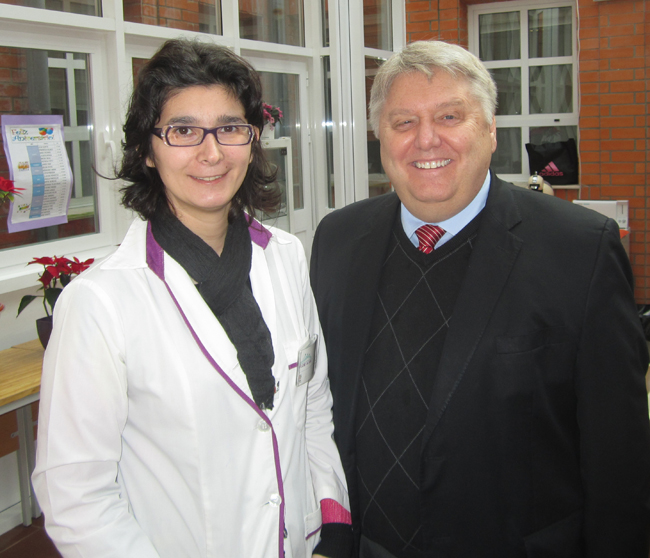 Dra Veronica Colaco and Prof Rich Roberts. Notice the purple trim on her coat, which is her unit's color. (Left)
Dra Veronica Colaco and Prof Rich Roberts. Notice the purple trim on her coat, which is her unit's color. (Left)
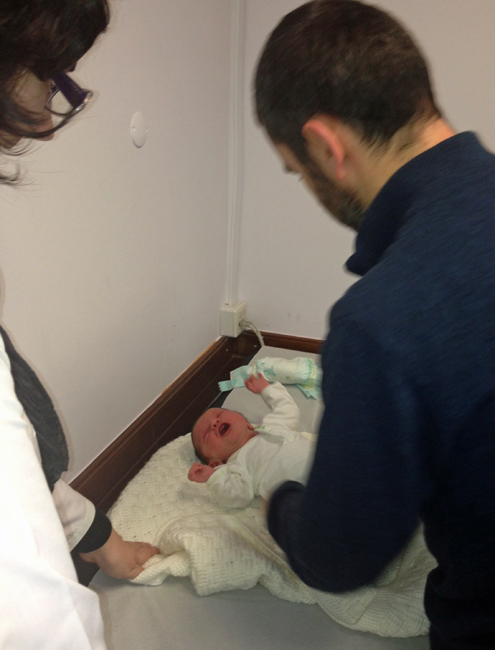
Dra Veronica with newborn and parent. (right)
In the USF Flor de Sal wing (Model A), Dra Veronica Colaço served as my host. During a typical work day, which consists of seven hours of consultations, she will see 20-30 patients. She showed me the electronic health record system, which facilitates the ready exchange of information between health centers and hospitals. She kindly allowed me to observe her with patients, which included a newborn baby brought in by her parents to establish care. I was pleased to see that Dra Colaço provided care to all age groups for a wide range of problems, including minor surgery. I also spoke about training in Portugal with Dra Joana Cristina Diaz, the director for residency training at the Aveiro Health Center. At the time of my visit, the Center had eight trainees (“internos”), six in Family Medicine, two in general residency as well as two nursing students.
Overall, I came away impressed with the Portuguese primary care system. The family doctors seemed well trained and highly motivated. They appeared to be eager, and more likely, to provide a wider range of services to entire families, while having a reasonable amount of time per consultation (about 15 minutes). Other systems often limit family doctors to certain age groups (e.g., adults only) or limit their consultation time to 3-5 minutes per patient. These limits reduce the positive impact that family doctors can have on the health of their patients and communities.
Back to Vasco
Another of my pleasant duties in Aveiro was to speak to the Portuguese arm of the Vasco da Gama Movement (VdGM), named after one of the most celebrated explorers of the Age of Discovery. Founded in 2005, VdGM (www.vdgm.eu) was the first multi-national group in the world formed by and for young family doctors in the European region. VdGM promotes education and training, Hippokrates exchanges, exchanges beyond Europe (especially Canada and Latin America), research, and the image of family doctors and Family Medicine. Like its namesake who discovered a route around Africa from Europe to India, VdGM aims to discover new directions for Family Medicine.
The VdGM meeting in Aveiro brought together 30 young family doctors, 13 of whom had participated recently in an exchange program. One program was Hippokrates, a two week exchange that allows participants to observe the care of patients in primary care, and the other was “mini Hippokrates,” which is connected to a meeting such as the Encontro and offers a one week sampling of another health system. Sites are reviewed, approved, and monitored to assure quality learning experiences. The exchange participants who attended the Encontro came from Czech Republic, France, Luxembourg, Portugal, Russia, and Spain. It was inspiring to hear the young doctors describe their exchange experiences and the perspectives they gained from spending time in another health care system. Their enthusiasm for Family Medicine and their commitment to improve the health of those they serve gave me hope for our next generation of family doctor leaders.
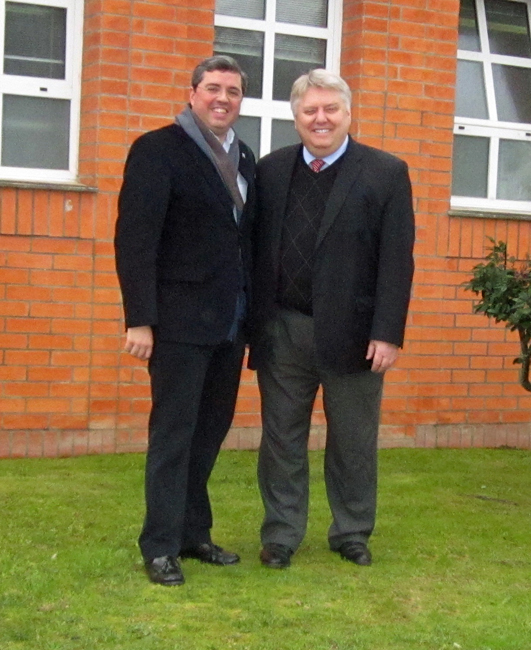 APMGF President Joao Carlos and Prof Rich Roberts in front of the Aveiro Health Center.
APMGF President Joao Carlos and Prof Rich Roberts in front of the Aveiro Health Center.
More on Vasco
Intrigued by the name selected by VdGM, I did more research on Vasco da Gama. Historians consider his voyage to India to be a seminal moment in human history. His unprecedented 10,000 km sailing across open seas was thought to be impossible. It is regarded as a key step toward globalization. Like most heroic stories however, there is more to the story.
We often think of heroes as solitary figures overcoming considerable odds to accomplish great achievements. Most heroes however, depend on others for inspiration and support. Much of the success of da Gama was the result of others who supported or came before him. King John II was eager to end the monarchy’s reliance on the nobility by building up the royal treasury through commerce. India was seen as the financial solution to a political problem. The spice trade out of India was viewed as a golden opportunity, if only an unencumbered path could be found. Until da Gama’s expedition, the Venetians controlled much of the European trade with India via a Middle Eastern route. Consequently, the king was willing to bet on a young captain in his twenties to find a way around Africa to India. Previous explorers such as Prince Henry the Navigator and Bartolomeu Dias mapped the African coast and proved it possible to sail around the Cape of Good Hope to the Indian Ocean. Pero da Covilhã and Afonso De Paiva traveled through the Middle East to scope out the spice trade and confirm the potential riches.
On 20 May 1498, da Gama and his ships landed in India, more than 10 months after departing Lisbon in July 1497. It was not until August 1499 that da Gama returned to Portugal. During the 25 months at sea, da Gama’s expedition lost more than half its men and two of its four ships. Portugal’s purse and power grew after the da Gama expedition, but not for reasons one might expect.
The two ships that made it back were laden with enough spices to yield a 60 fold return on the funds invested in the expedition. Portugal’s place as a dominant force on the seas was secured by da Gama’s voyage. Yet, da Gama ultimately failed in his quest to secure contracts in India and East Africa for future trade. His ruthless tactics, such as firing cannons on civilians and cutting off the hands of competing merchants, so alienated potential trading partners that they refused to deal with him. For the next 20 years, da Gama was a political outcast. In 1519, after threatening to move to Spain as Magellan had done, da Gama was appointed Count of Vidigueria by King Manuel I and became the first Portuguese count who was not a royal from birth.
The lessons of Vasco
Hopefully without stretching the analogy too far, I believe that da Gama’s cautionary tale can teach us some things about Family Medicine. Da Gama’s heroic act was in finding inspiration and using knowledge learned from others to take a great risk and accomplish a bold vision. Family doctors have a similarly bold vision: a healthier and more equitable world where every family has a family doctor. We believe this because we know that having a family doctor improves the effectiveness, efficiency, and equity of health care services. We will achieve this vision only by remembering the wisdom of those who preceded us, by responding to changing circumstances as they arise, and by taking necessary risks. As we grow in numbers and influence, we must be mindful that our power is earned through our service to others. It is not a birthright or entitlement. Our challenge is to overcome the obstacles (without cannons or amputations!) while staying true to the vision.
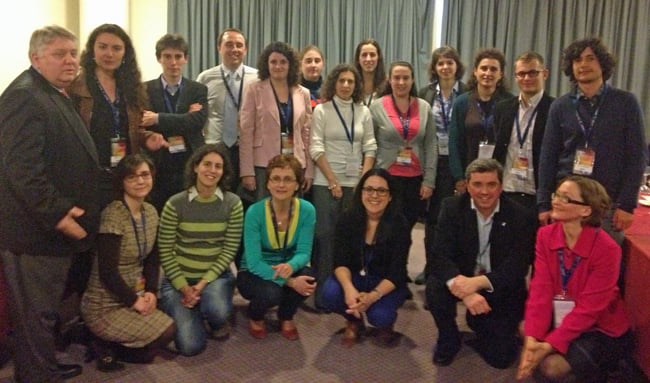 Closing ceremony - Vasco da Gama meeting participants.
Closing ceremony - Vasco da Gama meeting participants.
The young VdGM family doctors in Aveiro reminded me of these basic leadership principles and of the vision that guides us. I am certain that their intellect, innovation, enthusiasm, and commitment will lead us to better health care and a better world. I hope that our descendants will look back 500 years from now and conclude that we helped them become the kind of family doctors that we need, and that they can be.
Professor Richard Roberts
President
World Organization of Family Doctors
.